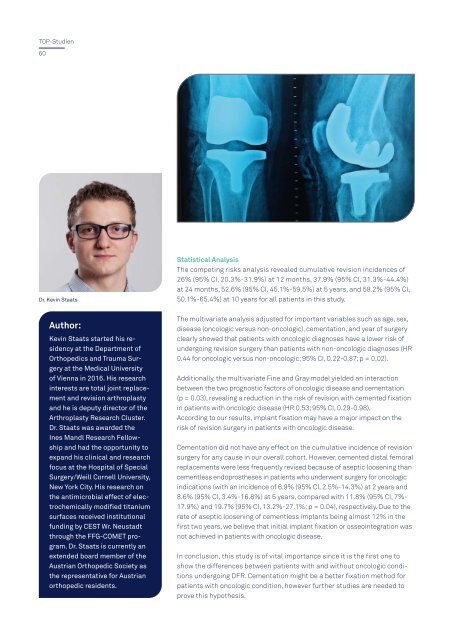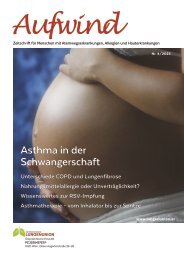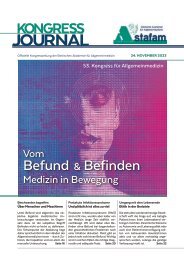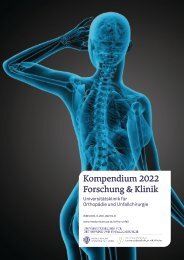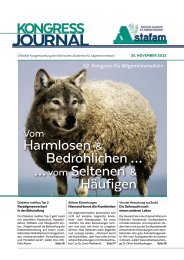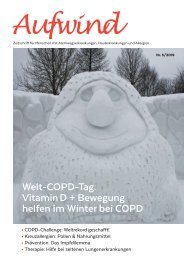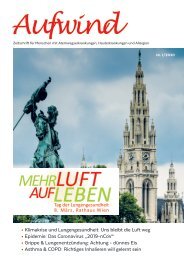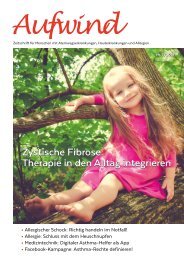Kompendium 2020 Forschung & Klinik
Das Kompendium 2020 der Universitätsklinik für Orthopädie und Unfallchirurgie von MedUni Wien und AKH Wien (o. Univ.-Prof. R. Windhager) stellt einen umfassenden Überblick über die medizinsichen Leistungen und auch die umfangreichen Forschungsfelder dar. Die Veröffentlichungen zeigen die klinische Relevanz und innovative Ansätze der einzelnen Forschungsrichtungen. Herausgeber: Universitätsklinik für Orthopädie und Unfallchirurgie MedUni Wien und AKH Wien Prof. Dr. R. Windhager ISBN 978-3-200-07715-7
Das Kompendium 2020 der Universitätsklinik für Orthopädie und Unfallchirurgie von MedUni Wien und AKH Wien (o. Univ.-Prof. R. Windhager) stellt einen umfassenden Überblick über die medizinsichen Leistungen und auch die umfangreichen Forschungsfelder dar. Die Veröffentlichungen zeigen die klinische Relevanz und innovative Ansätze der einzelnen Forschungsrichtungen.
Herausgeber: Universitätsklinik für Orthopädie und Unfallchirurgie
MedUni Wien und AKH Wien
Prof. Dr. R. Windhager
ISBN 978-3-200-07715-7
You also want an ePaper? Increase the reach of your titles
YUMPU automatically turns print PDFs into web optimized ePapers that Google loves.
TOP-Studien<br />
60<br />
Dr. Kevin Staats<br />
Statistical Analysis<br />
The competing risks analysis revealed cumulative revision incidences of<br />
26% (95% CI, 20.3%-31.9%) at 12 months, 37.9% (95% CI, 31.3%-44.4%)<br />
at 24 months, 52.6% (95% CI, 45.1%-59.5%) at 5 years, and 58.2% (95% CI,<br />
50.1%-65.4%) at 10 years for all patients in this study.<br />
Author:<br />
Kevin Staats started his residency<br />
at the Department of<br />
Orthopedics and Trauma Surgery<br />
at the Medical University<br />
of Vienna in 2016. His research<br />
interests are total joint replacement<br />
and revision arthroplasty<br />
and he is deputy director of the<br />
Arthroplasty Research Cluster.<br />
Dr. Staats was awarded the<br />
Ines Mandl Research Fellowship<br />
and had the opportunity to<br />
expand his clinical and research<br />
focus at the Hospital of Special<br />
Surgery/Weill Cornell University,<br />
New York City. His research on<br />
the antimicrobial effect of electrochemically<br />
modified titanium<br />
surfaces received institutional<br />
funding by CEST Wr. Neustadt<br />
through the FFG-COMET program.<br />
Dr. Staats is currently an<br />
extended board member of the<br />
Austrian Orthopedic Society as<br />
the representative for Austrian<br />
orthopedic residents.<br />
The multivariate analysis adjusted for important variables such as age, sex,<br />
disease (oncologic versus non-oncologic), cementation, and year of surgery<br />
clearly showed that patients with oncologic diagnoses have a lower risk of<br />
undergoing revision surgery than patients with non-oncologic diagnoses (HR<br />
0.44 for oncologic versus non-oncologic; 95% CI, 0.22-0.87; p = 0.02).<br />
Additionally, the multivariate Fine and Gray model yielded an interaction<br />
between the two prognostic factors of oncologic disease and cementation<br />
(p = 0.03), revealing a reduction in the risk of revision with cemented fixation<br />
in patients with oncologic disease (HR 0.53; 95% CI, 0.29-0.98).<br />
According to our results, implant fixation may have a major impact on the<br />
risk of revision surgery in patients with oncologic disease.<br />
Cementation did not have any effect on the cumulative incidence of revision<br />
surgery for any cause in our overall cohort. However, cemented distal femoral<br />
replacements were less frequently revised because of aseptic loosening than<br />
cementless endoprostheses in patients who underwent surgery for oncologic<br />
indications (with an incidence of 6.9% (95% CI, 2.5%-14.3%) at 2 years and<br />
8.6% (95% CI, 3.4%-16.8%) at 5 years, compared with 11.8% (95% CI, 7%-<br />
17.9%) and 19.7% (95% CI, 13.2%-27.1%; p = 0.04), respectively. Due to the<br />
rate of aseptic loosening of cementless implants being almost 12% in the<br />
first two years, we believe that initial implant fixation or osseointegration was<br />
not achieved in patients with oncologic disease.<br />
In conclusion, this study is of vital importance since it is the first one to<br />
show the differences between patients with and without oncologic conditions<br />
undergoing DFR. Cementation might be a better fixation method for<br />
patients with oncologic condition, however further studies are needed to<br />
prove this hypothesis.


